Remember December 7th
It seems that in recent years, the American national memory has grown shorter and shorter. Even after the attacks of 9/11, three years without a terrorist attack on our soil has left our country complacent, struggling to remember just what it was that got us all so worked up on that fall day.
It wasn't always this way. Time was, the American people forced each other to remember national tragedy. It was acceptable in times past to keep the memory of attack and death close at hand, as a reminder of the dangers our nation faced, and an exhortation to victory.
On December 7, 1941, our country suffered in some ways an even more shocking and devastating blow than on 9/11. The American battleship was not just a symbol of American power, it was the literal vehicle of that power. In a matter of hours, not only had the symbols of our strength been demolished, but the actual means of projecting strength were sunk or burning off the coast of Oahu. That the American aircraft carriers were spared was significant in the long run, but at the time appeared to be poor consolation. Carrier warfare had yet assume the importance that it would in short order. All that Americans knew at the time was that our big ships were gone, and the entire west coast was vulnerable to attack and possibly even invasion.
The America of that age did not allow itself to forget this attack. There was no compunction about showing the photographs of our sunken fleet, no worries over whether citizens would be offended at the site of our mighty navy burning in port. There was only the immediate and overwhelming need to rally against the enemy, swiftly and without hesitation.
On December 7, 1941, here are a few of the images you might have seen had you been a participant in the events of that day (These photographs and others can be viewed at the Naval Historical Center website).
Battleship Row, as seen from a Japanese torpedo plane, as the attack begins. Note the white lines in the water on the left side of the photograph, as the torpedoes streak towards their targets.
Battleship Row, from a different angle, as a Japanese dive bomber begins its attack. The splashes around several of the ships indicate the attack is already underway.
A color frame from a motion picture camera running at the moment the forward magazine of the U.S.S. Arizona explodes.
A Japanese dive bomber again, above the Arizona immediately after the forward magazine exploded.
The destroyer U.S.S. Shaw exploding during the second wave of the Japanese attack.
The U.S.S. Oklahoma capsized after being struck by 9 Japanese torpedoes. The explosions opened a 250 foot hole in her port side. Survivors tapped out SOS in Morse code on the inside of the hull, but only 32 were rescued the following day. The Oklahoma remained capsized until 1943, when she was rolled back over in a massive salvage operation.
Perhaps the most famous photograph from Pearl Harbor, the U.S.S. West Virginia billows smoke after being struck by several torpedoes, while a launch rescues survivors.
I believe that remembering the past is important. I believe that national tragedy is not something to be shoved into a closet or swept under the rug. What has happened to us that we have become so comfortable and sanguine and easily offended that we dare not recall or display the images of 9/11 as generations before did with Pearl Harbor? Why do our people allow themselves to forget the horror, fear, and the just anger that we experienced that day? The Pearl harbor generation will soon be gone forever, but they have not forgotten their day of infamy. What does that say about our generation, when so many seem to have so swiftly forgotten our own?
It wasn't always this way. Time was, the American people forced each other to remember national tragedy. It was acceptable in times past to keep the memory of attack and death close at hand, as a reminder of the dangers our nation faced, and an exhortation to victory.
On December 7, 1941, our country suffered in some ways an even more shocking and devastating blow than on 9/11. The American battleship was not just a symbol of American power, it was the literal vehicle of that power. In a matter of hours, not only had the symbols of our strength been demolished, but the actual means of projecting strength were sunk or burning off the coast of Oahu. That the American aircraft carriers were spared was significant in the long run, but at the time appeared to be poor consolation. Carrier warfare had yet assume the importance that it would in short order. All that Americans knew at the time was that our big ships were gone, and the entire west coast was vulnerable to attack and possibly even invasion.
The America of that age did not allow itself to forget this attack. There was no compunction about showing the photographs of our sunken fleet, no worries over whether citizens would be offended at the site of our mighty navy burning in port. There was only the immediate and overwhelming need to rally against the enemy, swiftly and without hesitation.
On December 7, 1941, here are a few of the images you might have seen had you been a participant in the events of that day (These photographs and others can be viewed at the Naval Historical Center website).
Battleship Row, as seen from a Japanese torpedo plane, as the attack begins. Note the white lines in the water on the left side of the photograph, as the torpedoes streak towards their targets.
Battleship Row, from a different angle, as a Japanese dive bomber begins its attack. The splashes around several of the ships indicate the attack is already underway.
A color frame from a motion picture camera running at the moment the forward magazine of the U.S.S. Arizona explodes.
A Japanese dive bomber again, above the Arizona immediately after the forward magazine exploded.
The destroyer U.S.S. Shaw exploding during the second wave of the Japanese attack.
The U.S.S. Oklahoma capsized after being struck by 9 Japanese torpedoes. The explosions opened a 250 foot hole in her port side. Survivors tapped out SOS in Morse code on the inside of the hull, but only 32 were rescued the following day. The Oklahoma remained capsized until 1943, when she was rolled back over in a massive salvage operation.
Perhaps the most famous photograph from Pearl Harbor, the U.S.S. West Virginia billows smoke after being struck by several torpedoes, while a launch rescues survivors.
I believe that remembering the past is important. I believe that national tragedy is not something to be shoved into a closet or swept under the rug. What has happened to us that we have become so comfortable and sanguine and easily offended that we dare not recall or display the images of 9/11 as generations before did with Pearl Harbor? Why do our people allow themselves to forget the horror, fear, and the just anger that we experienced that day? The Pearl harbor generation will soon be gone forever, but they have not forgotten their day of infamy. What does that say about our generation, when so many seem to have so swiftly forgotten our own?
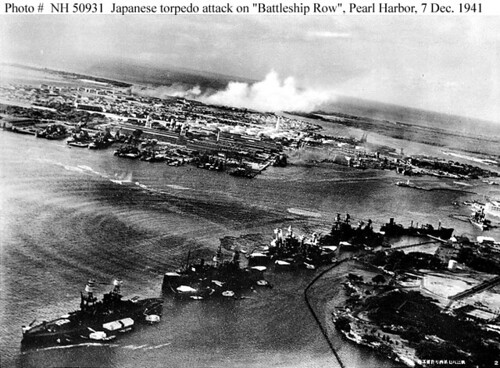
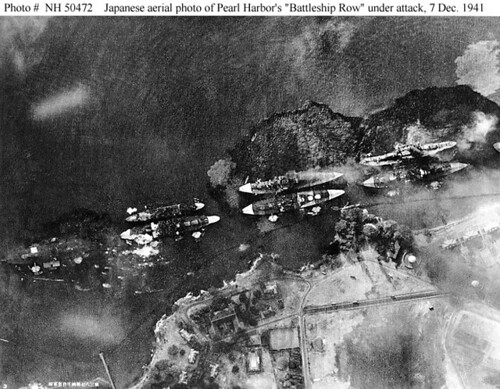
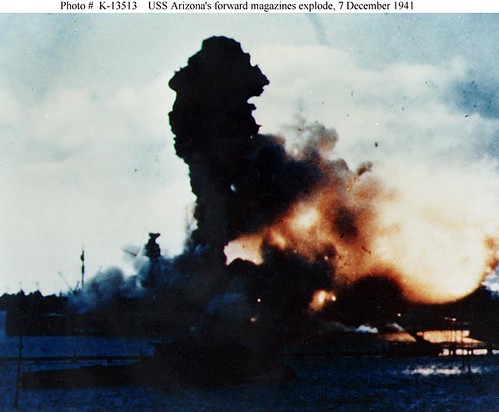
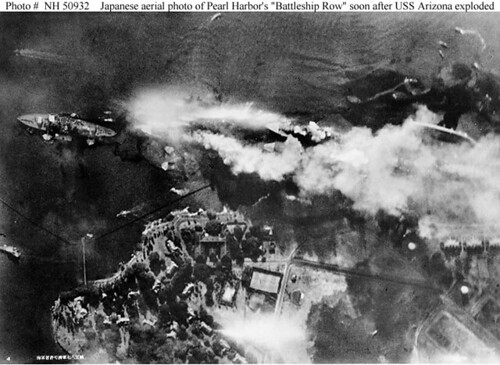
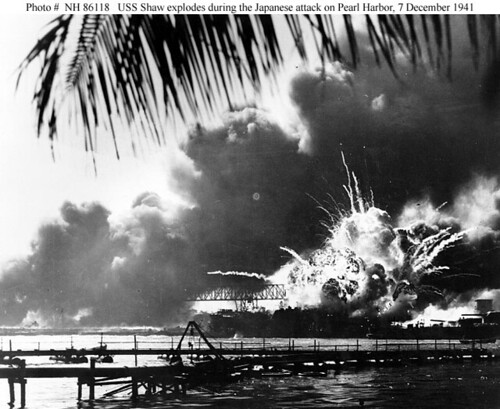
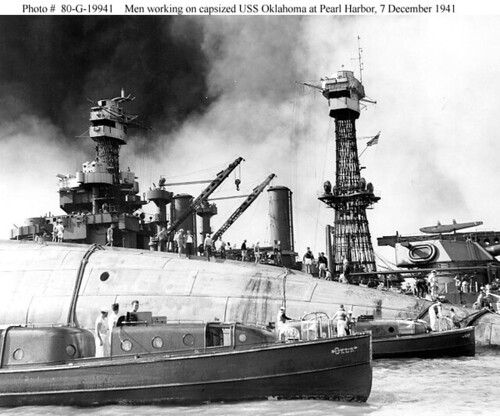
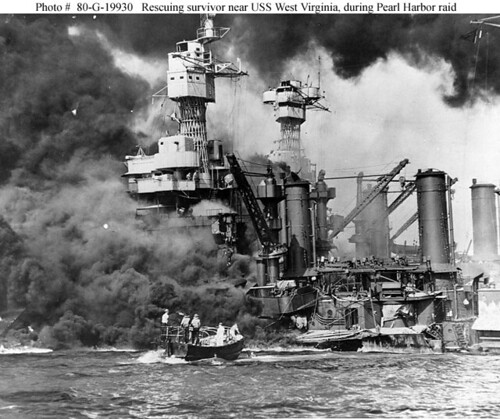





<< Home